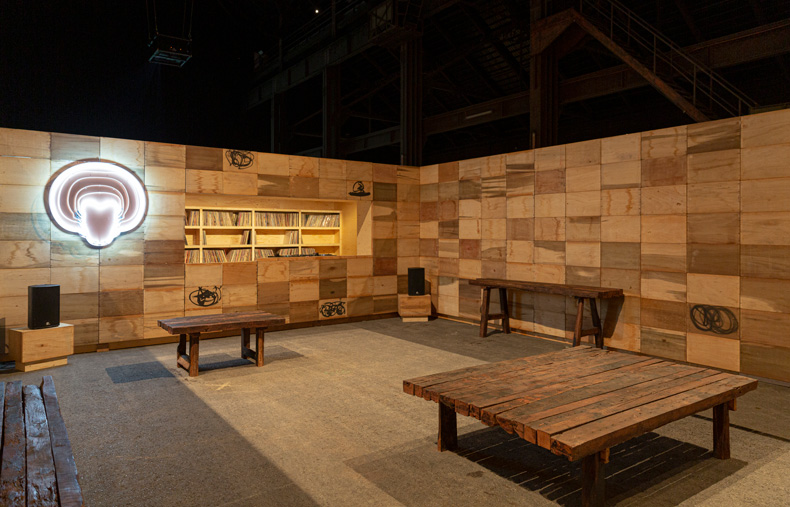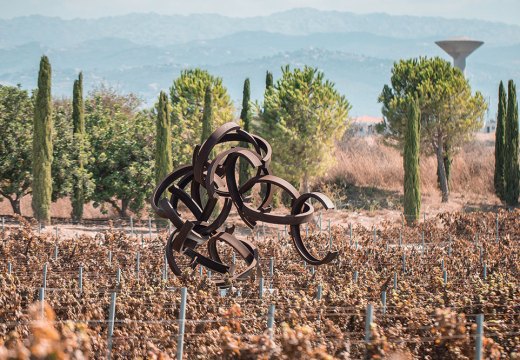From the September 2023 issue of Apollo. Preview and subscribe here.
The city of Tokoname in central Japan has been famed for its pottery since the 12th century. It was here that the American artist (and avowed Japanophile) Theaster Gates studied ceramics – and here, too, that the Hakurou brewery has brewed saké since 1848.
For the first project in Gates’s three-year residency at LUMA Arles, its vast Grande Halle – a 5,000-square-metre former ironworks – is hosting an unusually convivial exhibition: ‘Min I Mon’. Its title combines two Kanji characters – min, meaning ‘people,’ and mon, meaning ‘gate’. The public are invited in to gather in a saké bar and DJ booth made of repurposed wood, where the artist is sharing his personal collection of 2,500 R&B, soul and funk vinyl records. Here, visitors are offered a ceramic cup containing MON, a newly-created kara (extra-dry) saké Gates has created in partnership with the Hakurou brewery. It is a welcome drink, but it is also a navigation tool that visitors are handed to help piece together the complexities playing out both in this exhibition and in Gates’s practice as a whole.
The production of this drink is laden with meaning in itself. Hakurou still insists on using traditional tools and techniques to create its rice wine, choosing to use equipment such as wagama (cauldron-like rice steamers) and kojibuta (wooden trays used for fermenting rice). It was while studying in Tokoname that Gates first encountered the Japanese philosopher Soetsu Yanagi’s concept of mingei, variously translated as ‘folk craft’ or ‘art of the people’. Yanagi extolled the value of everyday objects such as textiles, ceramics and baskets, made by artisans whose identities are usually lost to history. Gates adapted the philosophy to develop a hybrid version he dubs ‘Afro-Mingei’: his way of honouring the creativity and craftsmanship within Black culture, marginalised by what he has called ‘Western-White Sameness’. There are elements of both mingei and Afro-Mingei present in ‘Min I Mon’. Here, Gates argues that craft – in the form of the saké cups, the wooden bar, the music – all belong in a cultural institution, which has traditionally been the preserve of Western fine art. He even includes the tradition of making and serving saké within this category of craft.

MON, a saké created by Theaster Gates in partnership with Hakurou. Photo: courtesy Theaster Gates and White Cube
Creating and sharing the saké also connects to arguments Gates has made about craft as the culmination of a body of knowledge. Making saké is complex: production begins with polishing grains of rice to precisely the right level, extracting impurities without interrupting the chemistry that will develop flavours. In Japan, saké classification is not awarded by appellation, but rather by the degree of polishing. The ensuing grade is the marker of superiority (and price, as you shave away your yield). Smaller grains are washed and soaked in preparation for steaming, during which the starch becomes gelatinised. Next, in preparation for fermentation, koji mould is mixed in with water and yeast to convert starch to sugar. The way the koji is mixed varies according to house style, giving each producer the individual characteristics of its saké. Hakurou have not changed their koji formulation for centuries, producing it with water and yeast from the same area of Aichi Prefecture. The ensuing mix is fermented in multiple stages then pressed, filtered and finally aged.

Installation view of ‘Theaster Gates: Min | Mon’ at LUMA Arles. Photo: © Victor & Simon – Joana Luz / Renata Pires
Wine is, of course, routinely served at gallery events, but Gates’s act of bringing rice wine into LUMA is more than just an offer of refreshment. It allows us to become part of the artwork, taking our place in a procession of visitors who came before us and will go after us. Saké plays a role in many rituals in Japanese culture. These include purification rites in Shinto ceremonies, weddings (where it is served in cups shared by the couple) and as a libation offered to graves of venerated ancestors; it even features occasionally in the revered tradition of the tea ceremony. At LUMA, the drink can simply be taken at face value as an expression of craft. However, creating and serving the saké also demonstrates Gates’s concern with the ritualistic fine-tuning of their skills that craftspeople undertake when making everyday objects. By building a bar in a cultural institution and offering the saké to the public, visitors are invited to reflect on such ideas.
Gates deploys such gatherings as a potentially disruptive force, challenging the way we sit back and passively observe art in institutions – not least thanks to the transgressive potential of alcohol. We are there to be challenged, but we are also the recipients of his hospitality. After all, we are the artist’s min.
From the September 2023 issue of Apollo. Preview and subscribe here.
Unlimited access from just $16 every 3 months
Subscribe to get unlimited and exclusive access to the top art stories, interviews and exhibition reviews.














![Masterpiece [Re]discovery 2022. Photo: Ben Fisher Photography, courtesy of Masterpiece London](http://www.apollo-magazine.com/wp-content/uploads/2022/07/MPL2022_4263.jpg)
It’s time for the government of London to return to its rightful home